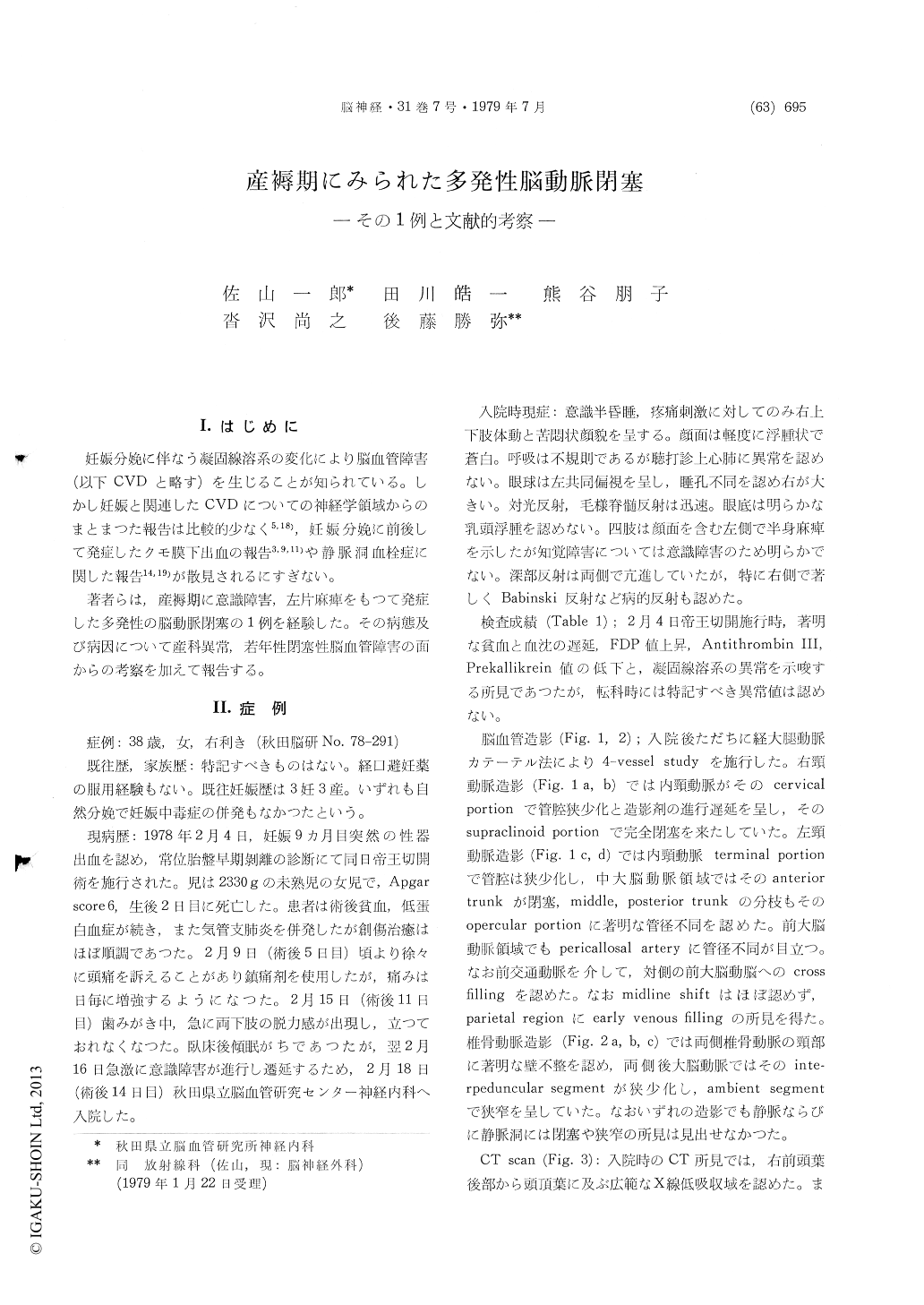Japanese
English
- 有料閲覧
- Abstract 文献概要
- 1ページ目 Look Inside
I.はじめに
妊娠分娩に伴なう凝固線溶系の変化により脳血管障害(以下CVDと略す)を生じることが知られている。しかし妊娠と関連したCVDについての神経学領域からのまとまつた報告は比較的少なく5,18),妊娠分娩に前後して発症したクモ膜下出血の報告3,9,11)や静脈洞血栓症に関した報告14,19)が散見されるにすぎない。
著者らは,産褥期に意識障害,左片麻痺をもつて発症した多発性の脳動脈閉塞の1例を経験した。その病態及び病因について産科異常,若年性閉塞性脳血管障害の面からの考察を加えて報告する。
A case of pregnancy-associated stroke was re-ported. And comparison was made with previously reported cases. Etiologic factors were discussed from the view point of pregnancy-associated blood dyscrasia and juvenile strokes.
A woman, aged 38, Gravida 3, Para 3, had a cesarean section for ablatio placentae in the ninth month of pregnancy. On llth day after the operation, she suddenly fell and complained of generalized weakness. As disturbance in conscious-ness progressed, she was transferred to our clinic 3 days after the onset. On admission, the clinical findings were as follows ; semicomatous, pale and edematous appearance, respiratory irregularity, conjugate deviation to the left, anisocoria, left hemiplegia, and hyperreflexia on the right side. Hematologic studies on admission were almost within normal limit. However, those at the time of cesarean section had disclosed abnormal coagu-lation and fibrinolysis in addition to blood-loss type anemia. 4-vessel study done on the day of ad-mission, revealed multiple stenotic changes in the trunks and branches of cerebral arteries. CT showed multiple low density areas, especially right posterior frontal, right parietooccipital junctional area, and left posterior temporal region. With gradual disappearance of disturbance in conscious-ness, disorder in higher cortical function, such as forced grasping, left spatial neglect, and dressing apraxia, became manifest. Follow-up angiography done one month after the onset, revealed that pathologic changes on admission were almost dis-appeared except for the delay in circulation of parieto-occipital junctional area on the left side. Two month after the onset, the patient was trans-ferred to rehabilitation hospital.
Generally, the cause of ischemic stroke duringpregnancy and puerperium had been assumed to be primarily venous lesion. But after angiographic confirmation had done, it became evident that those stroke were mainly due to arterial lesion. In such reported cases, site of arterial lesion were chiefly restricted to internal carotid territory. On the other hand, our experienced case had multiple arterial occlusion and/or stenosis not only in internal carotids and their branches, but also in vertebro-basilar system. At first, the findings in our case mentioned above, had suspicions about disseminated intravascular coagulation or fibromuscular dysplasia. But those were neglected by other investigation. After all, etiology of multiple arterial occlusion in this case was obscure, but the failure of hemostatic balance, so called "latent DIC" or"localized intra-vascular coagulation" may some role, in addition to "hypercoagulable state" and decreased activity of fibrinolysis which usually exist in the third trimester of gestation and early puerperium.
In cases of juvenile stroke, platelet aggreability and hyperactivity of coagulation are said to be detected. Our case may belong to one of these groups etiologically.

Copyright © 1979, Igaku-Shoin Ltd. All rights reserved.


